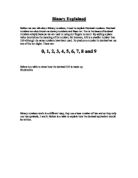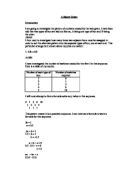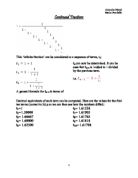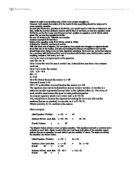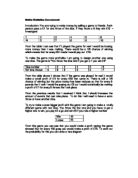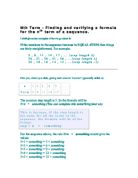Binary Explained.
Binary Explained Before we can talk about Binary numbers, I need to explain Decimal numbers. Decimal numbers are also known as denary numbers and Base ten. Ten is the bases of decimal numbers simply because we are used to using our fingers to count. By adding a place value determines the meaning of the number, for instance, 192 is a smaller number than 219 although the same numbers have been used. To produce a number in decimal we use one of the ten digits. These are: 0, 1, 2, 3, 4, 5, 6, 7, 8 and 9 Below is a table to show how the decimal 235 is made up. Hundredths Binary numbers work in a different way, they use a base number of two and so they only use two symbols, 1 and 0. Below is a table to explain how the decimal equivalent would be written. This is how binary works. Because the binary system has a base of two, this means that each place number is a power of two. The table below shows the system. Table 1 If we look at the table and take the furthest column to the right and work our way the left, we see that: 2 to the power of 0 is = 1 2 to the power of 1 is = 2 (2x1 = 2) 2 to the power of 2 is = 4 (2x2 = 4) 2 to the power of 3 is = 8 (2x2x2 = 8) 2 to the power of 4 is = 16 (2x2x2x2 = 16) 2 to the power of 5 is = 32 (2x2x2x2x2 = 32) .......and so on. Now that the table is done we can start converting from binary numbers to
A baker's dozen
A Bakers Dozen Introduction I am going to investigate the pattern of numbers created by the task given. I have been told that two types of bun are laid out like so, A being one type of bun and B being the other: ABAB I then need to investigate how many times two adjacent buns must be swapped in order to sort the alternate pattern into two separate types of bun, one at each end. This particular arrangement shown above requires one switch: . AB-AB AABB I have investigated the number of switches needed for the first 5 in this sequence. Here is a table of my results: Number of each type of bun Number of switches required 0 2 3 3 4 6 5 0 I will now attempt to find a formula solve any value in this sequence. 0 1 3 6 10 1 2 3 4 1 1 1 This pattern means it is a quadratic sequence. I can now use a formula to work a formula for this sequence. 2a = 1 a = 0.5 3a + b = 1 .5 + b = 1 b = -0.5 a + b + c = 0 0.5 - 0.5 + c = 0 c = 0 an + bn + c 0.5n2 - 0.5n I have now found a formula which can be used to work out the number of switches required for any number of buns. I will now test the formula to see if it is correct. I will test the formula with the number 3. The outcome according to my table should be 3. 0.5 * 32 - 0.5 * 3 = 3 I will now prove my formula is correct using induction. In order to do this I will have to show two
Continued Fractions
Continued Fractions This 'infinite fraction' can be considered as a sequence of terms, tn: A general formula for tn+1 in terms of tn can now be determined. It can be seen that tn+1 is 1added to 1 divided by the previous term. i.e. Decimal equivalents of each term can be computed. Here are the values for the first ten terms (correct to 5d.p as we can then see how the numbers differ): t1=1 t2= 1.50000 t3= 1.66667 t4= 1.60000 t5= 1.62500 t6= 1.61538 t7= 1.61905 t8= 1.61765 t9= 1.61818 t10= 1.61798 From looking at the graph we can see that for the first few terms the values fluctuate, but eventually the values fluctuate less and become very close together. I.e. the values become closer together as the value of n increases. We can then conclude that as n increases tn˜tn+1. From this, we can now deduce a formula for tn+1 in terms of tn: We can also conclude that if tn˜tn+1, then tn-tn+1 will equal to zero. Any term (the nth term) can be determined using the above general formula (formula 1), but it requires having to calculate all the values up to that term. For example, the 200th term can be found but we would have to find all the values up to the 199th term. This is time-consuming and instead of having to do this, we can find a new general formula: (we can assume that tn=tn+1 when n is a large value) (this makes it easier to understand the origins of the
Towers of Hanoi.
Maths GCSE Coursework Task Towers of Hanoi Introduction We have been asked during this piece of coursework to investigate the Towers of Hanoi. The Towers of Hanoi is a simple game whereby you must move of a pile of 3, 4, 5 or any other number of discs (1, 2, 3, etc) of decreasing radii from 1 of 3 poles to another pole (A, B, C). You are only able to move one disc at a time and cannot place a larger disc on top of a smaller disc. You must also complete this task in the smallest amount of moves possible. Our ultimate task was to complete the game with 4 discs and then 5 discs using the smallest amount of moves, then to find a formula to find the smallest amount of moves for any number of discs. Simple cases: 4 discs After having tried to solve the puzzle with 4 discs I found that the smallest amount of moves possible was 15. (See fig. 1) 5 discs To try and make things slightly easier for myself I decided to use the first 15 moves I had used for 4 discs and then proceed from there. This method was effective and led me to find that the smallest number of moves was 31. (See fig. 2) Results and Formulas Number of discs Number of moves 2 3 3 7 4 5 5 31 When placing all the results into a table I noticed that if you take a certain number of moves for example 3 and then double it you end up with 6. You only then need to add another 1 to make 7, which is the
Algebra Basics
Algebra is quite an interesting topic, which many people struggle on, However I will explain the basics of it, the basics is that everything should be balanced in every equation question for example if there is a question of 2x+8=12x, you would need to make the xs balance in one side, whilst the number (being 8, here) is with its kind of numbers, so now the equation reads 8=12x-2x, as the 2x moves over it becomes from positive to negative, so it is 12x-2x which gives 10x, so now the equation is 8=10x So now 10 divide by 8= 10/8=5/4 as a fraction. Another example is 6+3x=12x-4 Balance the equation so its 6+4=12x-3x, which is 10=9x 9 divided by 10=9/10, and leave it as that. With this basic rule of algebra, it is compulsory that people who struggle on algebra should know this rule as the basics, and also by knowing the balance of equations such as this should help when doing more complex algebraic equations. So to sum up, remember balance the x numbers with its kind and the normal numbers with its kind, note, that the letter could be anything, not just x, but even y or m etc. I will give more examples such as the question, 2X +9= 4X -8 Now I allow the time for you to work it out, it should take less then a two minutes work out. Now I will reveal the answer 2X - 4X= -8-9 8X=-17 X=17/8 Now for Mixed fraction the answer is 2 1/8 Because 8 times 2=16 6+1=17 so
How does the use of numbers, statistics, graphs, and other quantitative instruments affect perceptions of the validity of knowledge claims in the human sciences?
How does the use of numbers, statistics, graphs, and other quantitative instruments affect perceptions of the validity of knowledge claims in the human sciences? During the last centuries people saw that experiments helped answer many questions about nature. Scientists were able to prove pattern and theories related to nature. Experiments became an essential factor for science because science is based on facts and in order to prove these facts to be true scientists know that by having experiments they are able to prove their theories and patterns of nature. Since humans are part of nature also, experiments can be done on us to show certain patterns of behaviours or maybe theories about our behaviour or about human nature. These studies on the human race are divided into many categories mainly called human sciences. These studies are called sciences because the use of numbers in collecting data and analysing them are essential to prove certain events. In todays society numbers became really important because it is an element that is essential in our life, starting from the money that we use to buy our daily needs to knowing how to count. Whenever humans encounter numbers in magazines they tend to believein them. Any quantitative instrument is believed in todays society because it is known that most of the quantitative instruments that are available are very precise. Precision
Maths Statistics Dice Investigation
Maths Statistics Coursework Introduction: You are trying to make money by selling a game to friends. Each person pays a £1 for one throw of the dice. If they throw a 6 they win £10 - Investigate 2 3 4 5 6 4 5 7 6 8 0 From the table I can see that if I played the game for real I would be loosing more money than I was making. There would be a 1/6 chance of winning which means that for every £6 I made I would pay out £10. To make the game more profitable I am going to design another one using one dice. The game is "You throw the dice and if you get a 1 you win £5" Dice number 2 3 4 5 6 No' time thrown 9 8 8 9 9 7 From the table above it shows that if the game was played for real it would make a small profit of £5 for every £50 that came in. There is still a 1/6 chance of winning but the prize money has been reduces so that for every 6 pounds that I took I would be paying out £5 so I would statistically be making a profit of £1 for every 6 throws that took place From the previous results that I received I think that I should increase the amount of events that can take place. To do this I will need to have a extra throw or have another dice. To try to make a even bigger profit with this game I am going to make a totally different game with two dice. You throw the first one and you have to get a higher one to
Dehumanisation and the Holocaust.
Dehumanisation and the Holocaust All the Jews had to wear all the same clothing so that they could be recognised as Jews. Gentiles who saw these people in these clothes knew that they were Jews and they could treat them how they liked not as humans as to the Gentiles the Jews were not humans. This is dehumanisation because they are not being treated as humans by wearing those clothes they are labelled as Jews, and not humans. This made such atrocities 'easier' to commit as they were being labelled as non - human and Jews so a picture is put into their heads that they are not human so it doesn't matter how they feel. The Viennese anti- Semitic picture paper depicts the Jew as a world-devouring vampire. They are dehumanising the Jews by describing the as "world- devouring vampires" whereas they are completely human and are not at all vampires. They have never done anything wrong to any Gentiles and aren't doing anything wrong, just believing something different to everyone but this does not mean they are world- devouring vampires. This made such atrocities 'easier' to commit as an image of a world- devouring vampire is being put into their heads, instead of normal human beings. The picture of a railway straight track going directly through the arch of a building represents a factory, mechanical, going straight in and straight out, they don't have a choice of where they are
Consecutive Sums
Consecutive Sums Someone tells you that it is possible to make any number by writing an addition sum using only consecutive numbers. EXAMPLE 18 = 3 + 4 + 5 + 6 6 = 1 + 2 + 3 21 = 1 + 2 + 3 + 4 + 5 + 6 A) Is this person right? B) Can you make every number? C) Investigate and write down everything that you notice, as you go along. (E.g. patterns) ____________________________________________ A) This person must be wrong as they said you could make "any number" and I cannot make 8,16,32,40,56,64,80,88,96 this is not any number I feel this is sufficient proof to say that you can not make 'any' number. B) You can not make every number as a lot of numbers in the eight times table can not be made such as 8,16,32,40,56,64,80,88,96 so not every number can be made. C) CON NUMBERS 2 CON NUMBERS 3 CON NUMBERS 4 CON NUMBERS 5 CON NUMBERS 0 + 1 2 3 +2 0+1+2 4 5 2+3 6 +2+3 0+1+2+3 7 3+4 8 ** ** ** ** ** 9 4+5 2+3+4 0 +2+3+4 1 5+6 0+1+2+3+4+5 2 3+4+5 3 6+7 4 2+3+4+5 5 7+8 4+5+6 +2+3+4+5 6 ** ** ** ** ** 7 8+9 8 5+6+7 3+4+5+6 9 9+10 20 2+3+4+5+6 21 0+11 6+7+8 22 4+5+6+7 23 1+12 24 7+8+9 25 2+13 3+4+5+6+7 26 5+6+7+8 27 3+14 8+9+10 28 ** ** ** ** ** 29 4+15 30 9+10+11 6+7+8+9 4+5+6+7+8 I have noticed there is an equal gap each time. The more consecutive numbers the bigger the gap between
Nth Term - Finding and verifying a formula for the nth term of a sequence.
Nth Term - Finding and verifying a formula for the nth term of a sequence. I shall give some examples of how to go about it. If the numbers in the sequence increase in EQUAL STEPS then things are fairly straightforward. For example: 5 , 8 , 11 , 14 , 17 , ... (step length 3) 26 , 31 , 36 , 41 , 46 , ...(step length 5) 20 , 18 , 16 , 14 , 12 , ...(step length -2) First you, draw up a table, giving each term its "counter" (generally called n) n 2 3 4 5 . . . Term 5 8 1 4 7 . . . The common step length is 3. So the formula will be 3×n + something (You can complete this something later on) This is because, if the step length is the same for all the terms in the sequence, the formula will be of the format: step × n + something For the sequence above, the rule 3×n + something would give the values 3×1 + something = 3 + something 3×2 + something = 6 + something 3×3 + something = 9 + something 3×4 + something = 12 + something 3×5 + something = 15 + something You then compare these values with the ones in the actual sequence - it should be obvious that the value of the something is +2 So the formula for the nth term is 3n + 2 That's Easy Enough! A second example.... n 2 3 4 5 . . . Term 26 31 36 41 46 . . . The common step length is 5. So the formula will be 5×n +


